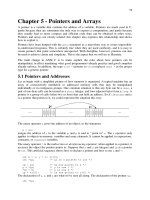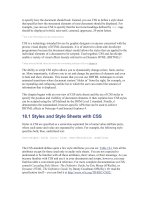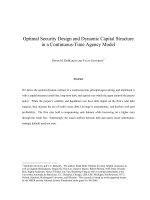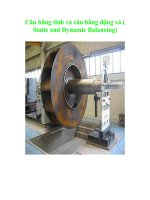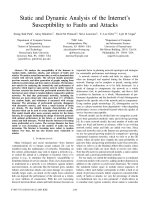Pointers and Dynamic Arrays
Bạn đang xem bản rút gọn của tài liệu. Xem và tải ngay bản đầy đủ của tài liệu tại đây (1.02 MB, 48 trang )
Copyright © 2007 Pearson Education, Inc. Publishing as Pearson Addison-Wesley
Chapter 9
Pointers and Dynamic Arrays
Slide 9- 3
Copyright © 2007 Pearson Education, Inc. Publishing as Pearson Addison-Wesley
Overview
9.1 Pointers
9.2 Dynamic Arrays
Copyright © 2007 Pearson Education, Inc. Publishing as Pearson Addison-Wesley
9.1
Pointers
Slide 9- 5
Copyright © 2007 Pearson Education, Inc. Publishing as Pearson Addison-Wesley
Pointers
A pointer is the memory address of a variable
Memory addresses can be used as names for
variables
If a variable is stored in three memory
locations, the address of the first can be used
as a name for the variable.
When a variable is used as a call-by-reference
argument, its address is passed
Slide 9- 6
Copyright © 2007 Pearson Education, Inc. Publishing as Pearson Addison-Wesley
Pointers Tell
Where To Find A Variable
An address used to tell where a variable is stored
in memory is a pointer
Pointers "point" to a variable by telling where
the variable is located
Slide 9- 7
Copyright © 2007 Pearson Education, Inc. Publishing as Pearson Addison-Wesley
Declaring Pointers
Pointer variables must be declared to have a
pointer type
Example: To declare a pointer variable p that
can "point" to a variable of type double:
double *p;
The asterisk identifies p as a pointer variable
Slide 9- 8
Copyright © 2007 Pearson Education, Inc. Publishing as Pearson Addison-Wesley
Multiple Pointer Declarations
To declare multiple pointers in a statement, use
the asterisk before each pointer variable
Example:
int *p1, *p2, v1, v2;
p1 and p2 point to variables of type int
v1 and v2 are variables of type int
Slide 9- 9
Copyright © 2007 Pearson Education, Inc. Publishing as Pearson Addison-Wesley
The address of Operator
The & operator can be used to determine the
address of a variable which can be assigned to a
pointer variable
Example: p1 = &v1;
p1 is now a pointer to v1
v1 can be called v1 or "the variable
pointed to
by p1"
Slide 9- 10
Copyright © 2007 Pearson Education, Inc. Publishing as Pearson Addison-Wesley
The Dereferencing Operator
C++ uses the * operator in yet another way with
pointers
The phrase "The variable pointed to by p" is
translated into C++ as *p
Here the * is the dereferencing operator
p is said to be dereferenced
Slide 9- 11
Copyright © 2007 Pearson Education, Inc. Publishing as Pearson Addison-Wesley
v1 and *p1 now refer to
the same variable
A Pointer Example
v1 = 0;
p1 = &v1;
*p1 = 42;
cout << v1 << endl;
cout << *p1 << endl;
output:
42
42
Slide 9- 12
Copyright © 2007 Pearson Education, Inc. Publishing as Pearson Addison-Wesley
Pointer Assignment
The assignment operator = is used to assign
the value of one pointer to another
Example: If p1 still points to v1 (previous
slide)
then
p2 = p1;
causes *p2, *p1, and v1 all to
name
the same variable
Slide 9- 13
Copyright © 2007 Pearson Education, Inc. Publishing as Pearson Addison-Wesley
Display 9.1
Caution! Pointer Assignments
Some care is required making assignments to
pointer variables
p1= p3; // changes the location that p1 "points"
to
*p1 = *p3; // changes the value at the location
that
// p1 "points" to
Slide 9- 14
Copyright © 2007 Pearson Education, Inc. Publishing as Pearson Addison-Wesley
The new Operator
Using pointers, variables can be manipulated
even if there is no identifier for them
To create a pointer to a new "nameless"
variable of type int:
p1 = new int;
The new variable is referred to as *p1
*p1 can be used anyplace an integer variable
can
cin >> *p1;
*p1 = *p1 + 7;
Slide 9- 15
Copyright © 2007 Pearson Education, Inc. Publishing as Pearson Addison-Wesley
Variables created using the new operator are
called dynamic variables
Dynamic variables are created and destroyed
while the program is running
Additional examples of pointers and dynamic
variables are shown in
An illustration of the code in Display 9.2 is
seen in
Display 9.2
Display 9.3
Dynamic Variables
Slide 9- 16
Copyright © 2007 Pearson Education, Inc. Publishing as Pearson Addison-Wesley
new and Class Types
Using operator new with class types calls
a constructor as well as allocating memory
If MyType is a class type, then
MyType *myPtr; // creates a pointer to a
// variable of type MyType
myPtr = new MyType;
// calls the default constructor
myPtr = new MyType (32.0, 17);
// calls Mytype(double, int);
Slide 9- 17
Copyright © 2007 Pearson Education, Inc. Publishing as Pearson Addison-Wesley
Basic Memory Management
An area of memory called the freestore is
reserved for dynamic variables
New dynamic variables use memory in the
freestore
If all of the freestore is used, calls to new will
fail
Unneeded memory can be recycled
When variables are no longer needed, they
can be deleted and the memory they used is
returned to the freestore
Slide 9- 18
Copyright © 2007 Pearson Education, Inc. Publishing as Pearson Addison-Wesley
The delete Operator
When dynamic variables are no longer needed,
delete them to return memory to the freestore
Example:
delete p;
The value of p is now undefined and the
memory used by the variable that p pointed to
is back in the freestore
Slide 9- 19
Copyright © 2007 Pearson Education, Inc. Publishing as Pearson Addison-Wesley
Dangling Pointers
Using delete on a pointer variable destroys the
dynamic variable pointed to
If another pointer variable was pointing to the
dynamic variable, that variable is also undefined
Undefined pointer variables are called
dangling pointers
Dereferencing a dangling pointer (*p) is usually
disasterous





